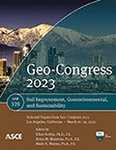Tunnel Boring Machine Crushed Limestone as a Cement Grout
Publication: Geo-Congress 2023
ABSTRACT
The recent advances in the construction of tunnels and subways in urban cities involve the use of tunnel boring machines (TBM). The use of TBM in Riyadh, Saudi Arabia, resulted in huge quantities of crushed limestone powder (≈3 million cubic meters) and generally treated as waste. This work is aimed at utilizing the fine portion of the crushed limestone (powder) as a cement grout material and its possible use in shotcrete and lining of the tunnel works. The suggested mixture can be an efficient replacement for the sand cement grouts or lean concrete used in tunnel lining. This material is expected to be cost-effective and environmentally friendly as less cement and sand need to be used. The proposed mixture was subjected to geotechnical and material characterization as usually conducted for materials of similar applications. Mixtures of cement:powder of ratios 1:1, 1:1.2, and 1:1.4 were examined at a water-cement ratio of 0.6. Curing was carried out for 7, 14, and 28 days. Compressive strength tests were performed, and stress-strain relationships were established at early curing times and full-strength development to determine the crack initiation development as a key driven factor of a tunnel collapse. The results were compared to sand cement grout to measure performance improvement. The modes of failure and shear zones developed during tests were studied. Moreover, the impact of the crushed powder content on the strength and stress-strain relationship was evaluated. Characterization of the material, including particle size and shape description of the selected powder, was determined, and aggregate quality and durability tests were evaluated. The strength improvement due to the introduction of this material is attributed to the interlocking nature of the angular shape of particles. The workability of the mixture can be improved using additives of plasticizers, and this will enable using less water-cement ratio. More studies and examinations are suggested on the composition and gradation of the crushed limestone powder obtained from the tunnel-boring machine.
Get full access to this article
View all available purchase options and get full access to this chapter.
REFERENCES
El-Kelesh, A. M., and Matsui, T. (2002). “Compaction Grouting and Soil Compressibility”, Proceedings of the Twelfth International Offshore and Polar Engineering Conference Kitakyushu, Japan, May 26–31, 2002, 2002.
Alnuaim, A., Dafalla, M., and Al-Mahbashi, A. (2020). “Enhancement of Clay–Sand Liners Using Crushed Limestone Powder for Better Fluid Control”. Arabian Journal for Science and Engineering, 45(1), 367–380.
Alnuaim, A., Abbas, Y. M., and Khan, M. I. (2021). “Sustainable Application of Processed TBM Excavated Rock Material as Green Structural Concrete Aggregate”. Construction and Building Materials, 274, 121245.
Al-Mahbashi, A. M., and Dafalla, M. (2022). “Shear strength prediction for an unsaturated Sand Clay Liner”. International Journal of Geotechnical Engineering, 16(3), 282–292.
Aquino, C., Inoue, M., Miura, H., Mizuta, M., and Okamoto, T. (2010). “The effects of limestone aggregate on concrete properties”, Construction and Building Materials 24(12):2363–2368. DOI: https://doi.org/10.1016/j.conbuildmat.2010.05.008.
ASTM. ASTM D 3148–96. (1996). Standard test for elastic moduli of intact rock core specimens in uniaxial compression, ASTM International, West Conshohocken, PA, USA.
ASTM. ASTM D2487-17. (2017). Standard Practice for Classification of Soils for Engineering Purposes (Unified Soil Classification System), ASTM International, West Conshohocken, PA, www.astm.org. https://doi.org/10.1520/D2487-17.
Dafalla, M., Al-Mahbashi, A., and Alnuaim, A. (2021). “Characterization and assessment of crushed limestone powder and its environmental applications”. IOP Conference Series: Earth and Environmental Science (Vol. 727, No. 1, p. 012013). IOP Publishing.
Bayer, I. R. (2004). Use of Preplaced Aggregate Concrete for Mass Concrete Application, Master Thesis, the Graduate School of Natural and Applied Sciences of Middle East Technical University, 2004.
Lothenbach, B., Saout, G., Gallucci, E., and Scrivener, K. (2008). “Influence of limestone on the hydration of Portland cements”, Cement and Concrete Research, Vol. 38, 2008, pp. 848–860.
Makhloufi, Z., Bouziani, T., Bédérina, M., and Hadjoudja, M. (2014). “Mix proportioning and performance of a crushed limestone sand-concrete”. J. Build. Mater. Struct. (2014) 1: 10–22.
Information & Authors
Information
Published In
History
Published online: Mar 23, 2023
Authors
Metrics & Citations
Metrics
Citations
Download citation
If you have the appropriate software installed, you can download article citation data to the citation manager of your choice. Simply select your manager software from the list below and click Download.
